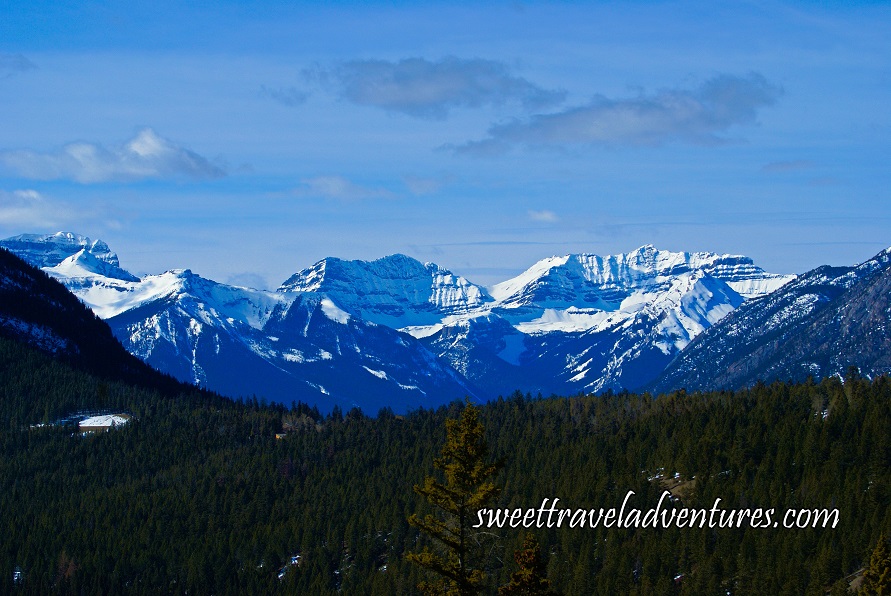
The Rocky Mountains in Banff National Park, Alberta
Banff National Park is known worldwide as a place of incredible beauty. It is located in the Rocky Mountains, about 1-1.5 hours west of Calgary, in Alberta, Canada. Every year the park attracts approximately 4 million visitors, many from all over the world, due to its breathtaking scenery. It is one of the most visited national parks in Canada as well as North America. It is also Canada’s oldest national park, as it was established in 1885, North America’s second national park (founded after Yellowstone National Park), and the world’s third national park. Moreover, Banff National Park is a year-round tourist destination with its peak season in July and August. The park is a UNESCO World Heritage Site and spans 6,641 square kilometres (2,564 square miles) of protected wilderness areas containing valleys, mountains, glaciers, forests, meadows, lakes, rivers, waterfalls, hot springs, and a large variety of wildlife.
The Rocky Mountains, also commonly called the Rockies, were initially formed from 80 million to 50 million years ago from shifting tectonic plates and erosion by glaciers. The Rockies stretch from Canada to the United States. The Canadian Rockies consist of shale and limestone and have an extensive number of high peaks and northwest-southeast trending ranges. The highest mountain entirely located in Banff National Park is Mount Forbes, with a height of 3,612 metres (11,850 feet). Although Mount Assiniboine is slightly higher than Mount Forbes at 3,618 metres (11,870 feet), it is only partially situated in Banff National Park and actually stands in three parks, including; Banff National Park, Kootenay National Park, and Mount Assiniboine Provincial Park.
There is a wide variety of plants, wildflowers, and wildlife as 96 percent of Banff National Park is wilderness. Some other interesting facts are that there are over 1,000 glaciers in the park and the Bow River in Banff flows as far as Hudson’s Bay.
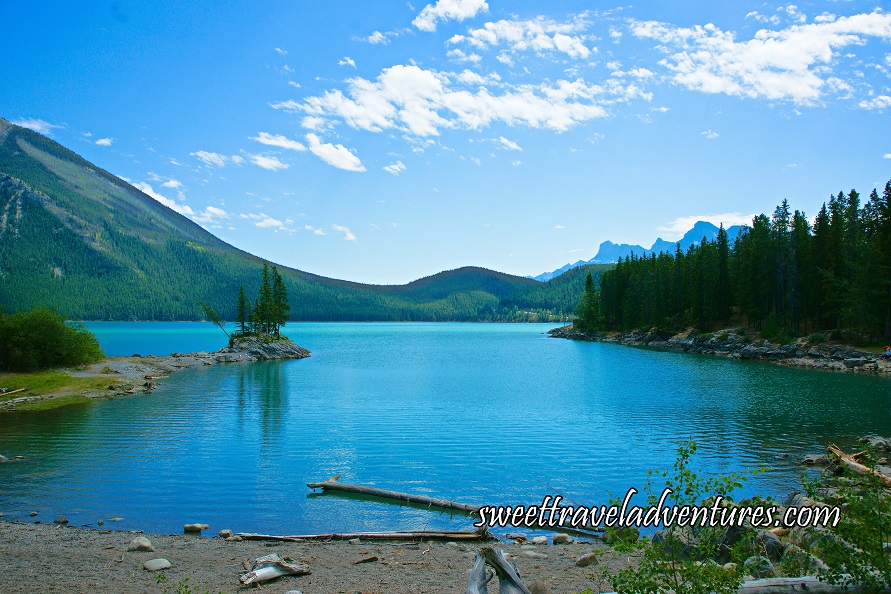
Lake Minnewanka in Banff National Park, Alberta in Summer
Here is some detailed information about Banff National park that will help you to better plan your visit and get the most out of your trip:
Activities Available
Banff National Park is an unspoilt wilderness and a wonderful place for singles, couples, families, nature lovers, outdoor enthusiasts, athletes, and artists. There are a large number of cultural events, festivals, and sporting events that take place in the park throughout the year. Celebrities may be spotted in the area as there are occasionally star studded fundraising events or festivals frequented by high profile Hollywood actors and actresses. Other popular activities in Banff National Park include hiking, downhill skiing/snowboarding, cross country skiing, angling/fishing, mountain biking, cycling, mountaineering, snowshoeing, dog sledding, horse-drawn sleigh rides, bird watching, ice skating, horseback riding, canoeing, white water rafting, golfing, and ski touring, among many others.
Prohibited Activities
Several activities are prohibited in Banff National Park as they are not compatible with the park’s goals of conservation. The activities that are not allowed include; collecting natural objects (such as wildflowers, rocks, mushrooms, berries, etc.) or cultural objects (for example, arrowheads), hunting, motorized off-road travelling, ice fishing, snowmobiling, paragliding, parachuting, hang gliding or any heavier-than-air aircraft, and use of personal watercraft (such as Sea Doos, Jet Skis, etc.) or water skiing equipment.
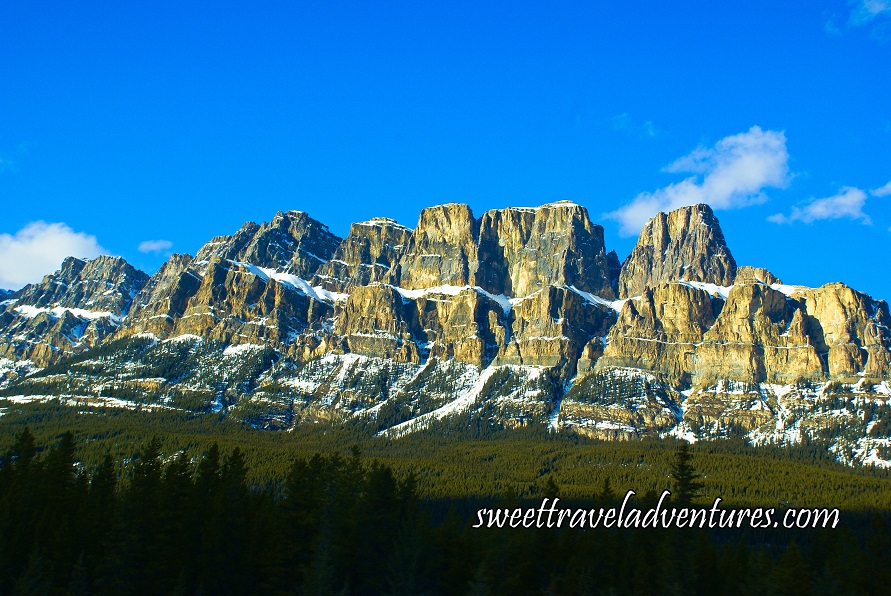
Castle Mountain in Banff National Park, Alberta
Movies/TV Shows Filmed in Banff National Park
Banff National Park has often served as the backdrop in several Canadian and international movies and TV shows due to the beauty of the area. Movies/TV shows which have been filmed in and/or feature Banff National Park include: Drawing Home (2014), The Right Kind of Wrong (2013), The Bachelor (TV Series, Season 17, Episode 6, 2013), The Amazing Race Australia (TV Series, Season 2, Episode 10, 2012), One Week (2008), Coil (2001), Mystery Alaska (1999), The Edge (1997), Last of the Dogmen (1995), Destiny Ridge (1993 TV Series), Due South (1994 TV Series), Days of Heaven (1978), among many others. For a more complete list see here.
Ecoregions or Zones
Many precious ecosystems exist in Banff National Park, which are further divided and classified based on vegetation, landforms, and soil. This land classification system identifies similar regions within the park so as to better manage the park’s ecosystems. The three major ecoregions or zones are: the montane, subalpine, and alpine.
The montane region contains valleys, grasslands, alders, willows, birches, cottonwoods, Douglas firs, and lodgepole pines. Most of the wildlife is found in this region.
The subalpine region is comprised of forest, mostly made up of spruce and pine trees, that extends from the montane region up to about 1,981 metres (or 6,500 feet).
The alpine region (above the treeline) consists of rocky terrain and is positioned at the highest elevations in the park. This, along with the cold strong winds, mean few plants and animals can survive there.
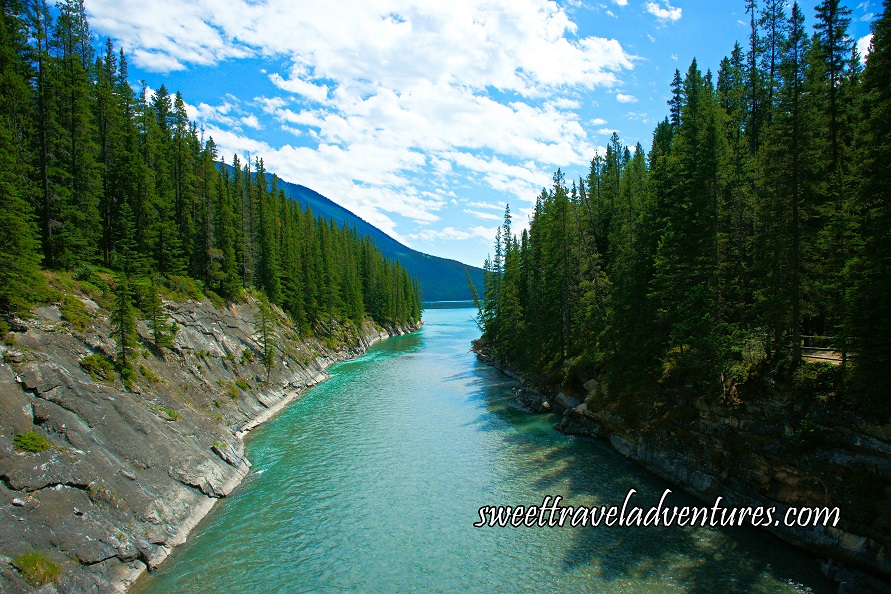
Cascade River Flowing Through Stewart Canyon in Banff National Park, Alberta
Wildlife
It is very common to encounter wildlife in Banff National Park; including in the town of Banff, along the side of the road, and even while hiking. On some trails it is mandatory to carry bear spray in case of an encounter with a bear as there are many grizzly bears and black bears in the area. There is a large variety of trails accessible to hikers including back country trails, however for safety reasons the back country should only be explored with a licensed guide or with someone with a number of years of back country experience in Banff National Park as the backcountry is quite isolated and can be quite rough terrain, not to mention increased chance of meeting wildlife such as cougars, and a high threat of avalanches occurring.
Banff National Park is the home of approximately 53 species of mammals as well as amphibians, reptiles, fish, birds, and insects. Some of the animals in this preserved area are rare or endangered. It is quite common to see elk, deer, mountain goats, chipmunks, squirrels, birds, and trout. Other animals in the park include Woodland caribou, wolverines, lynxes, frogs, salamanders, toads, garter snakes, various fish, harlequin ducks, shrews, bats, bighorn sheep, hares, geese, eagles, and the mountain pine beetle, among many others. This large diversity of animals in the park results from the wide range of habitats due to variations in elevation, climate, and plants.
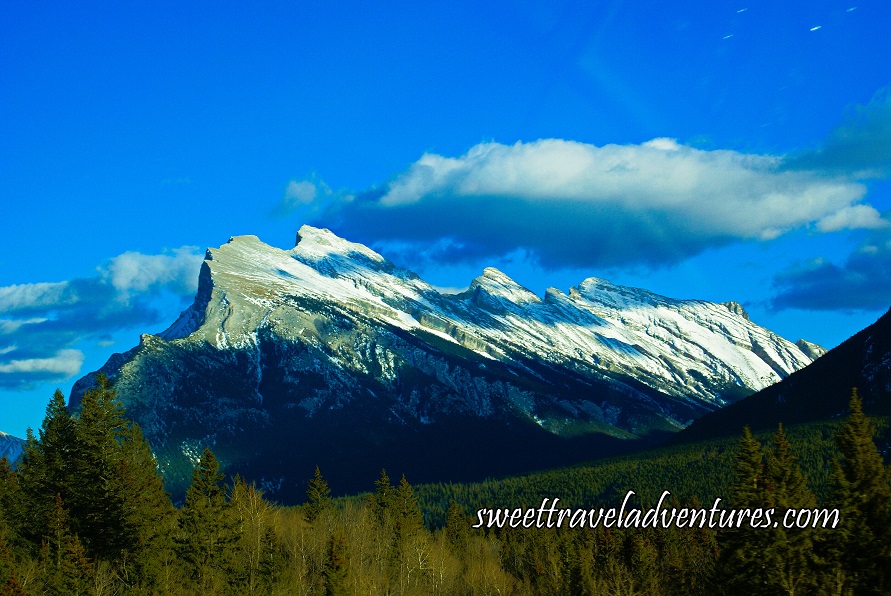
Mount Rundle in Banff National Park, Alberta
Climate and Weather
Banff National Park has a subarctic climate with mild summers and cold, snowy winters which are often moderated by Chinook winds (warm winds). The warmest temperatures occur in July (summer), with average daily highs of 22°C (72°F) and daily low temperatures averaging 7°C (45°F) for the town of Banff. The coldest month is January (which is in winter) with the mean high temperature of −5°C (23°F) and the mean low temperature of −15°C (5°F) for the Town of Banff. It is important to note that the temperature can drop into the minus thirties in winter. The relatively dry air, however, helps make even extreme temperatures more bearable, unless there is a wind chill. If there is a wind chill the temperature may feel a lot colder. Fortunately, Chinook winds frequently occur so extreme temperatures do not usually continue for more than a couple of weeks at a time.
In the montane region (the valleys) there is more precipitation in the summer (in the form of rain) than there is in the winter. In the sub-alpine and alpine regions there is more precipitation in the winter (in the form of snow) than precipitation in the summer.
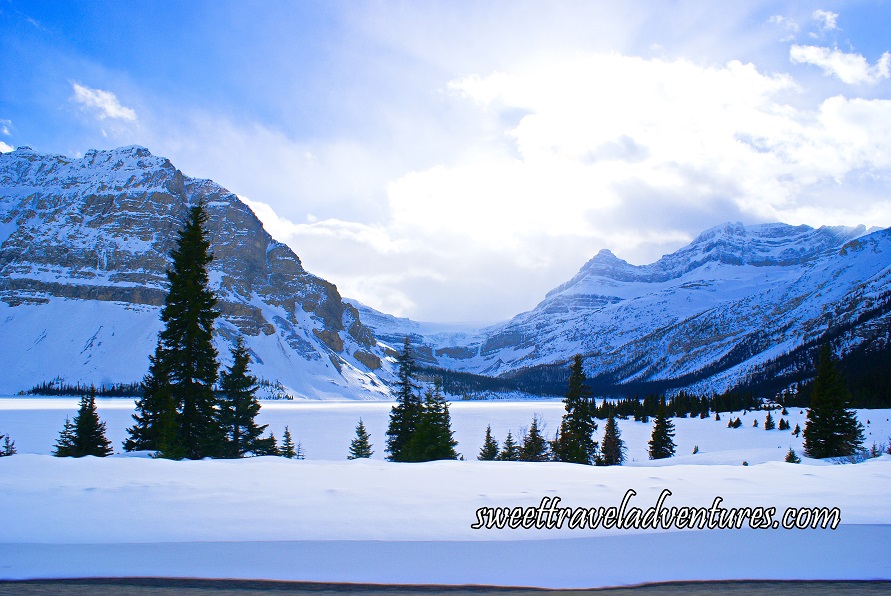
Bow Lake in Banff National Park, Alberta in Winter
Amount of Daylight
The length of day in Banff National Park fluctuates greatly throughout the year. In December daylight may last as little as eight hours while at the end of June when the day is longest, daylight may last as much as 16.5 hours with the sun rising at about 5:30 am and setting at approximately 10:00 pm.
Things to Be Aware of:
- Temperatures and weather can vary greatly throughout the park; therefore the weather at one specific location in the park may be quite different from other points relatively close by. For example, the village of Lake Louise receives about 76 centimetres (30 inches) of snow on average in December whereas the town of Banff gets approximately 44 centimetres (17 inches) on average.
- The weather in Banff National Park can change dramatically throughout the day so it is crucial to be prepared and to dress in layers. Furthermore, the weather can differ considerably from year to year and from day to day. No matter what time of year it is though the temperature will fall on average about 1°C for every 200 metre (656 foot) increase in elevation.
- Avalanches are very dangerous snow hazards in Banff National Park, especially after a fresh snow fall or when the temperature warms up and the snow is melting. Make sure you check avalanche warnings and conditions before skiing, hiking, or exploring in Banff National Park in order to check which areas may be at risk, especially when intending on going into the backcountry. Snow hazards can exist not only in winter but also in early spring and even in late spring and early June. If there is an avalanche risk it is best to change your plans and explore another area of the park that day.
- It is important to be aware of the effect that weather has on all the animals in the park and how they may respond as a result. For instance, during the winter months some animals, such as bears, hibernate while others adapt to the conditions, like voles, by travelling through tunnels in the snow. Yet some animals, such as bighorn sheep, must make their way down toward the valleys (montane zone) to find food as they are dependent on grass. Some animals may become aggressive if they are not able to find food so keep your distance.
- It is fairly common to see animals along the side of the road or on the roadway when driving through Banff National Park. Please reduce your speed when driving through the park as deer or other animals may bolt out suddenly to cross the highways or roads, especially around dusk. It is advisable to be ready to stop at any given time, even if you do not see an animal at the side of the road, as they may just not be visible in the bushes from the roadway. Deer are one of the top 10 killers of humans in the world due to traffic accidents with them. (See article).
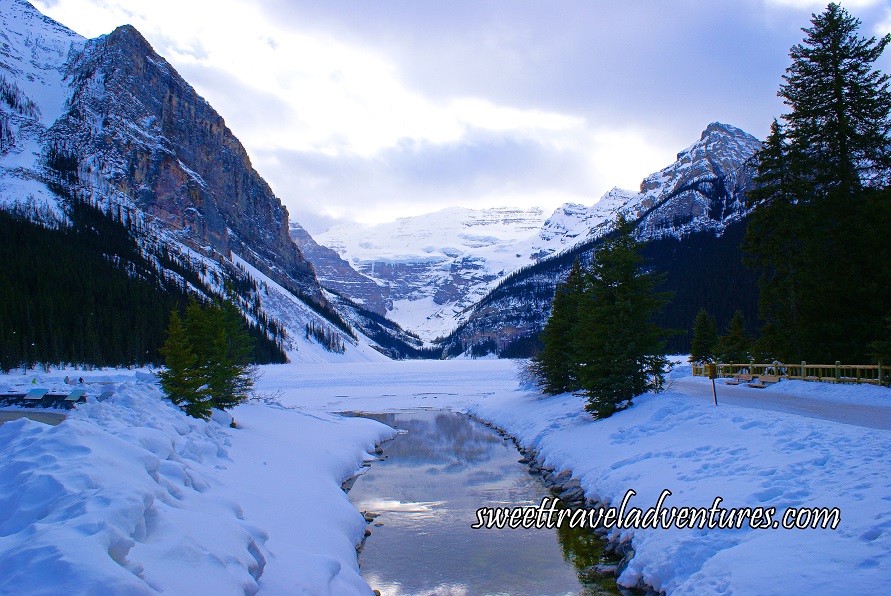
Lake Louise Covered in Snow in Banff National Park, Alberta in Winter
How to Get to Banff National Park
Calgary, Edmonton, and Vancouver are the major cities closest to Banff National Park, all of which have international airports serviced by major national and international carriers. Calgary is the nearest city and has direct bus service from the Calgary International Airport (as well as from other locations in Calgary) to Banff National Park. Buses will stop either in the town of Banff or in the village of Lake Louise. By vehicle Banff National Park is situated:
- 128 kilometres (80 miles) west of Calgary
- 401 kilometres (250 miles) southwest of Edmonton
- 850 kilometres (500 miles) northeast of Vancouver
- 26 kilometres (16 miles) west of Canmore
The Major Highways in Banff National Park Include:
- the Trans-Canada Highway or Highway #1 (runs west from Calgary into the park through Banff and Lake Louise and on to Vancouver)
- the Icefields Parkway or Highway #93 (runs between Lake Louise and Jasper Townsite)
- the Radium/Invermere Highway or Highway #93 (can be reached by taking the Castle Mountain Junction between the Trans-Canada Highway and Radium Hot Springs)
- the Bow Valley Parkway or Highway #1A (a scenic secondary highway paralleling the Trans-Canada Highway between the town of Banff and the village of Lake Louise)
Another option is to get to Banff by train, as there is a sightseeing rail service between Banff and Vancouver, but the service is limited and can be quite expensive.
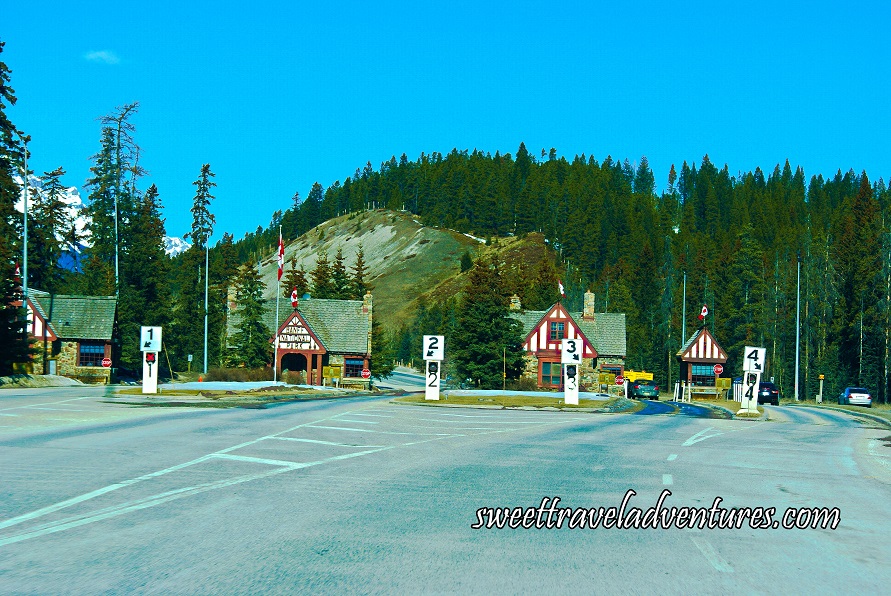
Entry Gates to Banff National Park Between Canmore and the Town of Banff, Alberta
Cost to Visit Banff National Park
All visitors to Banff National Park require a park permit. One can be obtained at the park entry gates or at one of the Visitor Centres. A new alternative is purchasing the parks pass online. Day passes and annual passes for one adult or a family/group are available which must be put on the left-hand side of your vehicle’s dashboard or on the rear-view mirror with the date visible through the window. The annual pass, also called the Discovery Pass, is more cost effective if you are going to spend 7 or more days in Canada’s national parks as this pass grants unlimited free access to many of Canada’s national parks as well as many of Canada’s national historic sites and national marine conservation areas for a period of one year. If you decide to purchase an annual pass online you can print off a temporary ticket to use before the pass arrives in the mail.
Visitors who have already purchased a Banff National Park Pass or a Discovery Pass, or those who do not intend to stop in the park are allowed to take the drive-through lane at the entrance of Banff National Park (the farthest lane on the right). If you are just passing through Banff National Park in transit to another destination and do not stop in the park then it is not necessary to purchase a permit. However, if you stop, even for just a few minutes to take a photo, take in the view, fill up gas, or have a meal, then a pass must be purchased. The park fees go towards the maintenance and preservation of Canada’s national parks and historic sites.
Hope you enjoy your visit to Banff National Park, one of my favourite national parks, and a must-see attraction near Calgary! 🙂
Map of Banff National Park
What is your favourite national park?
Entry to Banff National Park was with a complimentary Discovery Pass courtesy of Parks Canada. As always, all opinions are 100% my own.
Information compiled from Parks Canada, Wikipedia, Banff Lake Louise, and IMDb.
(Photos courtesy of Randy Smith).
118 246 
- 364Shares



I LOVE Banff! For the park and for the Castle located in the city. It is such a pristine National Park and full of so many elements, it’s easy to lose an entire day (or week) just walking around and exploring. I’m personally bias towards Mt. Rainier National Park, as its basically my back yard, but Banff NP is high up there on my list of favorites. 🙂
Yes, it’s very easy to lose time walking around and exploring Banff National Park. You are lucky to be fairly close to two such wonderful National Parks! 🙂
There is nothing more beautiful or breathtaking than the Rocky Mountains and the scenery in Banff National Park throughout the year, which you have so superbly presented. It was a pleasure reading and traveling through your exquisite photos. I could literally ‘see’ myself there, inhaling the crisp fresh air, immersing myself in nature’s immaculate beauty while hiking and exploring through the many activities available. Indeed a place I would LOVE to visit.
Thank you. 🙂 I am glad you enjoyed the article and pictures. I hope you get the opportunity to visit Banff National Park one day!
Wow I would love to go here! Great tips, I bookmarked your site! 🙂
You are welcome! 🙂 Hope you get the chance to explore Banff National Park!